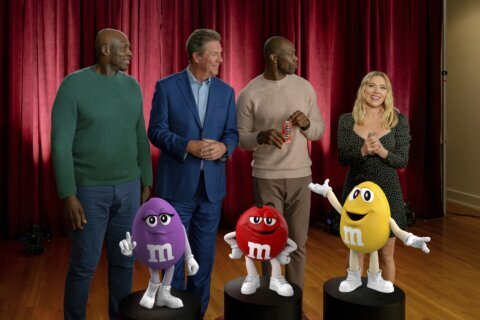WASHINGTON – The Writers Guild of America recently voted “The Wire” as one of the ten best-written television shows of all time, joining “The Sopranos,” “Seinfeld,” “The Twilight Zone,” “All in the Family,” “M*A*S*H,” “The Mary Tyler Moore Show,” “Mad Men,” “Cheers” and “The West Wing.”
Of those shows, it’s safe to say that “The Wire” was the least watched during its original TV run, and the most celebrated upon its rediscovery on home video.
Now, after a special HBO marathon over the holidays, the HD restoration of “The Wire” is available for digital purchase on Monday, Jan. 5, with the Blu Ray collection slated for this summer.
The HD restoration is one of the most significant in recent memory. The Baltimore-based TV drama debuted back in 2002, several years before widescreen televisions became the norm in American households. Thus, “The Wire” was shot in standard definition with a 4:3 aspect ratio, creating a more square-shaped image:
The new high-definition version converts the original 35mm negative into a 16:9 aspect ratio, better suited for your widescreen television (the opposite of the “pan and scan” technique, which Turner Classic Movies did a phenomenal job of explaining here).
Creator David Simon says the wider image amplifies many scenes of “The Wire.” In one scene near the end of Season 2, Simon writes in his blog, “The dockworkers are all that much more vulnerable, and that much more isolated … when we have the ability to go wider in that rare crane shot.”
However, he says, other scenes lose some power with the wider frame. For example, in the pilot episode, the confident Wee-Bey chats on the street with the uneasy D’Angelo, who symbolically stands beneath a neon sign reading “chicken,” signifying that he’s a coward:
The 16:9 transfer makes the frame wider, adding additional neon signs to the frame and making it harder to appreciate the tight, intentional blocking. The symbolic mise-en-scene remains; you just have to look harder to find it:
Like it or not, the transfer will at the very least allow new generations to appreciate arguably history’s greatest TV drama. No matter which format you watch, “The Wire” is a show for the ages.
What other show or film so seamlessly follows this many characters, all with interweaving story lines, all with immense character depth? You’d have to dig up Robert Altman’s “Nashville” (1975) to even come close. “The Wire” etches dozens of characters into our brains, from primary protagonists such as McNulty and Omar to primary antagonists such as Avon Barksdale and Stringer Bell. Secondary protagonists (Kima) pull our heartstrings just as much as secondary antagonists (Snoop), bringing us pause with three little words, “How’s my hair?”
We pull for Bubbles to kick his addiction.
We root for Prezbo to get through to his students.
And we howl each time Clay Davis arrives to recite his trademark, drawn-out piece of profanity.
Actress Brandy Burre spoke with WTOP about her Season Three role as Theresa D’Agostino. She recalls running Tommy Carcetti’s campaign for mayor and having an affair with McNulty:
WTOP also caught up with actor Tray Chaney, who played Poot, a drug dealer in the Barksdale Organization who appears in all five seasons. Chaney says the show’s fourth season, and its focus on education, inspired him to rap about staying in school in his music video “Attendance.”
“The fourth season gave me ideas for my ‘Attendance’ video, which helped parents, teachers, students and youth to understand that when young people are focused on being in school, they begin to develop a broader worldview and start to develop learning valuable social skills,” Chaney says. “The video was shot in Baltimore at the Maryland Academy of Technology and Health Science charter school because I wanted to capture the essence. Just think, the young people in the school could probably identify with a Namond, Dukie, Michael & Randy. It’s just the reality of it.”
Of course, the greatest character in the show is the city of Baltimore itself, its levels of corruption dissected through a different prism in each of the show’s five seasons.
Season One explores the drug trade in the streets and the cops on the front lines trying to stop it. Season Two explores how these drugs arrive into the city through the stevedores of the waterfront. Season Three explores the politics of lawmakers and law enforcement trying to contain the drug trade. Season Four explores how the broken education system creates dropout factories that churn hopeless kids back out into the drug trade. And Season Five explores the media reaction to crime, both for its vital fact-gathering and unfortunate sensationalism.
The five-season structure is the key to the show’s legacy. In a medium that invented the phrases “jump the shark” (“Happy Days”) and “move the island” (“Lost”), “The Wire” never overstayed its welcome. Perhaps this was due to the discipline of Simon and his fellow filmmakers. Or, perhaps it was simply because “The Wire” was always in the shadows of its older siblings “The Sopranos” and “Sex and the City,” and thus didn’t have to play the same ratings game.
Whatever the reason, this gem has flown under the radar for way too long.
No more. Or as a famous Baltimore poet once wrote: Nevermore.
If you’ve never seen “The Wire,” the HD restoration is the perfect excuse to discover it for the first time. If you’ve only seen it once, it’s the perfect chance to rewatch the show to notice all the symbolism you may have missed the first time around. And if you’re among the hardcore fans who have seen it multiple times, it’s the perfect time to soak it all in, now better than ever.
Technological updates like this are expected — it’s all in the game, yo.
But just like that nursery rhyme whistle on Omar’s deadly lips, some things are timeless.
So when you walk through the TV garden, you better watch your HD back.
Follow @WTOP and WTOP Entertainment on Twitter and WTOP on Facebook.








